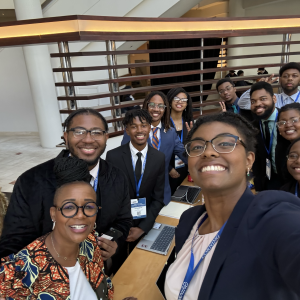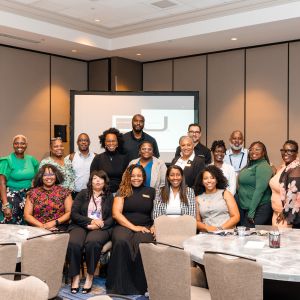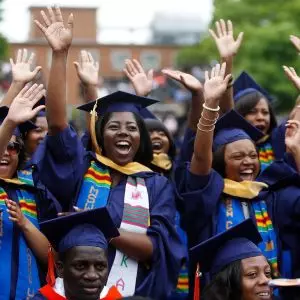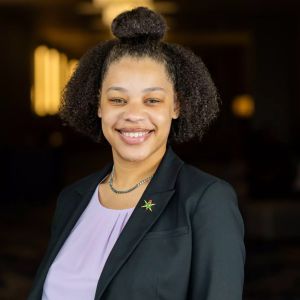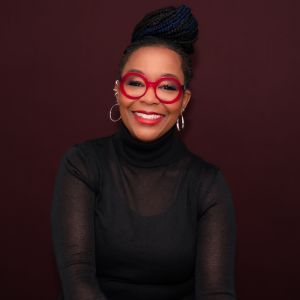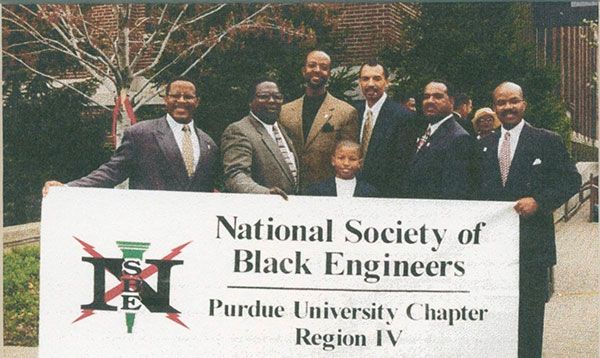

When broadcast journalist Cheryl Burton joined her on-air colleagues in reporting proudly from their high school alma maters last September, NSBE was there! Images of five of NSBE’s founding “Chicago Six” graced the Wall of Fame of Lindblom Math and Science Academy, where Burton, of ABC7 TV News in Chicago, graduated in 1980. The five faces on camera on the wall behind her belonged to Anthony (“Tony”) Harris, Brian Harris, Stanley (“Stan”) Kirtley, John Logan and George Smith, who earned their diplomas at the citywide magnet school on Chicago’s South Side in 1971. Later that year, they joined another South Sider, Edward Coleman from Chicago’ s Morgan Park High School, as engineering freshmen at Purdue University, where they and Purdue faculty member Arthur Bond, Ph.D., brought NSBE to life in 1975.
Lindblom (pronounced LIND-bloom) didn’t change much between their time there and Burton’s, the NSBE Wall of Famers report. The school remained selective, academically rigorous, encouraging of student self-confidence and leadership, and supportive of students’ ambitions for their lives post-graduation.
The JETS Set
Before Tony Harris became president of the Black Society of Engineers (BSE) at Purdue, later renamed the Society of Black Engineers (SBE), and before he led the SBE’s team effort to form the National Society of Black Engineers, he headed Lindblom’s Junior Engineering Technical Society (JETS).
“I’m sure being president of the JETS at Lindblom contributed to my desire to lead the Black Society of Engineers (later the Society of Black Engineers) as well as my becoming chairman of the Purdue student chapter of the American Society of Mechanical Engineers (ASME),” Harris says. “However, the most significant factor that contributed to our successful leadership of SBE and later NSBE was that we all had worked together on teams, in clubs and socially in high school, so we knew and trusted each other. That truly helped us navigate the ‘culture shock’ of West Lafayette (home of Purdue) as well as the politics of leadership. We had a built-in ‘study group’ and social network from day one!”
Founder George Smith recalls the “accelerated pace” of Lindblom’s curriculum, the technical education and vocational training that gave hands-on experience with various tools, and the emotional and spiritual support provided by the educators.
A Priceless Bond
“There was a fair number of Black teachers, and they were all great role models,” Smith recalls. “…They created an environment similar to what I would imagine is the environment at an HBCU. They encouraged you. You felt like the teachers’ success was a reflection of the students’ success, so I know that they wanted us to excel.”
Like Smith, and Tony Harris, Founder Brian Harris points to the relationships he cultivated there as the biggest benefit of his time in high school: “The Lindblom experience was monumental in many ways, and the friendships that I developed have lasted to this day…. George Smith, Anthony Harris, Stanley Kirtley, John Logan. Unfortunately, because of the passing of John and Stan, they’re no longer with us. But these are friendships that were established and have lasted our entire lives.”
While he praises JETS, and Lindblom’s “great instructors,” he also notes that “the degree of challenge academically was not the same at our high school as it was at some of the high schools of the students that we came in contact with as freshmen at Purdue.” Founder Tony Harris concurs, adding that none of Chigago’s public schools in inner-city neighborhoods offered calculus or AP classes then. Similar educational inequities still persist today.
Their more fortunate classmates at Purdue were “ahead of the curve as freshmen, whereas we were kind of in a remedial mode,” Founder Brian Harris continues. “We were playing catch-up. I think what set us apart was not so much academically how we were prepared but the confidence level that we had.”
“There were 4,000 or so students at Lindblom when we were there, and I believe that prepared us for the large university experience at Purdue,” says Founder Tony Harris. “Succeeding there gave me tremendous confidence that I could succeed at Purdue…. I was recruited by Phillips Exeter Academy, a well-known private boarding high school in New Hampshire that was looking to bring in Black students as part of a diversity initiative. I’m sooooo glad I didn’t go…and that says a lot!”


